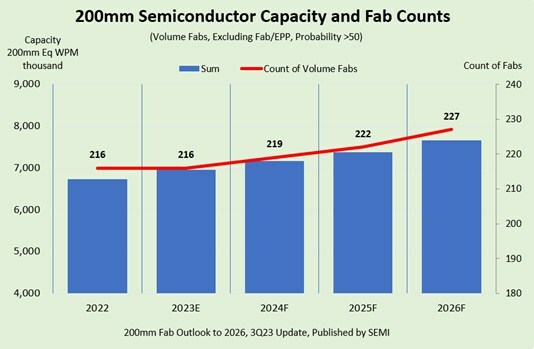
Global 200mm fabs to reach record high capacity by 2026, SEMI reports
by CM staff
The SEMI 200mm Fab Outlook to 2026 report shows fab capacity for automotive and power semiconductors growing 34 per cent from 2023 to 2026.

200mm Fab Outlook To 2026, SEMI
MILPITAS — Semiconductor manufacturers worldwide are projected to increase 200mm fab capacity by 14 per cent from 2023 through 2026, adding 12 new 200mm volume fabs (excluding EPI) as the industry reaches a record high of more than 7.7 million wafers per month (wpm), SEMI announced today in its 200mm Fab Outlook to 2026 report.
Power and compound semiconductors, which are vital for the consumer, automotive and industrial sectors, are the biggest drivers of 200mm investment. The development of powertrain inverters and charging stations for electric vehicles (EVs) in particular is expected to fuel increases in global 200mm wafer capacity as EV adoption continues to rise.
“The global semiconductor industry’s ramp to record 200mm fab capacity highlights the bullish expectations for growth in the automotive market in particular,” said Ajit Manocha, SEMI President and CEO. “While automotive chip supply has stabilized, the increased chip content in EVs and the drive to reduce charging time is spurring capacity expansions.”
Chip suppliers including Bosch, Fuji Electric, Infineon, Mitsubishi, Onsemi, Rohm, STMicroelectronics and Wolfspeed are accelerating their 200mm capacity projects to meet future demand.
The SEMI 200mm Fab Outlook to 2026 report shows fab capacity for automotive and power semiconductors growing 34 per cent from 2023 to 2026, with Microprocessor Unit/Microcontroller Unit (MPU/MCU) ranking second at 21 per cent, followed by MEMS, Analog, and Foundry at 16 per cent, 8 per cent, and 8 per cent, respectively.
Accounting for most of the 200mm fab capacity are 80nm to 350nm technology nodes. Growth of 80nm to 130nm node capacity is forecast to expand by 10 per cent, while 131nm to 350nm technology nodes are expected to register an 18 per cent expansion from 2023 to 2026.